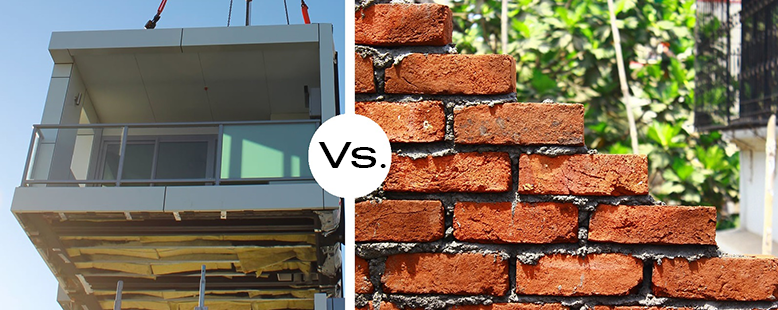If you are starting a construction project, one of the decisions that you will have to make is regarding Modular vs Traditional Construction methods. For a long time, traditional construction methods were considered a safe bet. It is what people were familiar with. Every construction project was built on the site and revolved around it.
But this construction method was challenged when modular construction was introduced. Conversely, a modular method gives one more control over the project. Every construction professional knows that creating a building from scratch is full of risks. There are unknown weather conditions, labor mishaps, poor financial plans, and so much more. Modular homes help to reduce all that by providing a secure and controlled setting for the construction of these buildings.
This article will help you a great deal in understanding both methods by exploring their various aspects in detail. It will include how these two methods differ from each other and their average costs.
Key Differences Between Modern Vs Traditional Construction
The following are the key differences between these two construction techniques:
1) Speed
Modular construction offers quicker project completion as opposed to on-site construction. This is because of the off-site preparation and fabrication of building components.
2) Efficient Quality
As components are manufactured in a controlled environment, this leads to uniform quality. Thus, ensuring accuracy and compliance with all the standards. There’s quality control in modular construction
3) Cost Efficiency
Modular homes have been regarded as more cost-effective than traditional homes. This is due to decreased labour costs and material wastage.
4) Flexibility in Designing
Traditional homes offer more design flexibility by allowing architects and builders to bring their unique vision to life with customization.
5) On-site Adaptability
When the building components are manufactured on site, it automatically offers better adaptability to specific site conditions and other environmental factors.
Cost Difference in Modular vs Traditional Construction
1) Process of Construction
The process of construction in a modular method is much faster than the traditional technique. Buildings are constructed in a factory and then transported to the location. In modular construction, every task is performed in a controlled environment. This eliminates the threat of any external or unfavorable conditions.
Whereas, traditional construction is prone to a number of uncertain variables, which can surely delay the process of construction.
2) Completion Time
As it has been mentioned above, the modular technique is faster. This is because parts of a building are developed in an off-site location. This means that the completion time of a modular building will be within the set timeframe.
Conversely, with traditional construction techniques, a delay has to be faced because of the site conditions. This may impact and increase the overall costs.
3) Chances of Risks
In modular construction, the chances of hazards are minimal. As the work is done in a controlled environment. This means that the safety standards have been applied throughout the fabrication process.
On the other hand, the chances of risks are higher in traditional construction. Thus, this method will require more cost in implementing the required safety standards.
4) Sustainability
Modular construction projects are built with materials that can be reused and recycled. Thus, promoting sustainability and ensuring a positive impact on the environment.
Traditional construction, on the other hand, is not considered sustainable at all. It is not flexible enough to be reused and recycled.
Prefab vs Traditional Construction Cost
1) Material Cost
In modular construction, material costs are lower for multiple reasons. One of the main reasons is that there is less material wastage. So, one only has to pay for the materials that will be used in the construction project.
On the contrary, in traditional construction, materials costs are usually higher because of the wastage factor.
2) Labor Cost
The controlled factory environment of modular construction methods means lower labor expenses. The chances of labor accidents or mishaps also decrease. Contrary to that, in traditional methods, labour costs are higher. This is because more labour is required to complete a project on time.
3) Transportation in Modular vs Traditional Construction
In modular construction, transportation costs are higher. As the prefabricated building components need to be transported from one point to another. But, in traditional construction, there will be fewer transportation costs as building parts are manufactured on site. But do keep in mind that one still has to pay for materials transportation expenses.
How to Further Reduce Expense?
1) Construction Takeoff Services
If you worry about the cost of construction, then Construction Takeoff Services is the best option for you! They help manage expenses by quantifying the exact materials required for a project. Moreover, they provide a complete cost estimation that includes labor, materials, equipment, and permit fees. To make the most of these insights, understanding the benefits of hiring a skilled general contractor is essential. A skilled GC can use these estimates to optimize resource allocation, prevent delays, and ensure the project stays on budget.
2) Materials Purchased in Bulk
Material purchased in bulk will be less costly as compared to buying the required material separately. Vendors tend to reduce the cost when the buyer orders a large amount of materials. Don’t forget to negotiate the numbers!
Conclusion
Between Modular Vs Traditional Construction, it is clear which is more advantageous financially. If you are looking for a cost-effective option for your next construction project, then modular construction can help you save money. On top of that, if you avail the services of a professional cost estimator, it can help you further decrease the cost. By reading this article, you will know in detail what method of construction is appropriate for your project. Additionally, it extensively discusses which method is more cost-effective. So, make sure to implement this article in the selection process to attain increased profits in your construction project.









